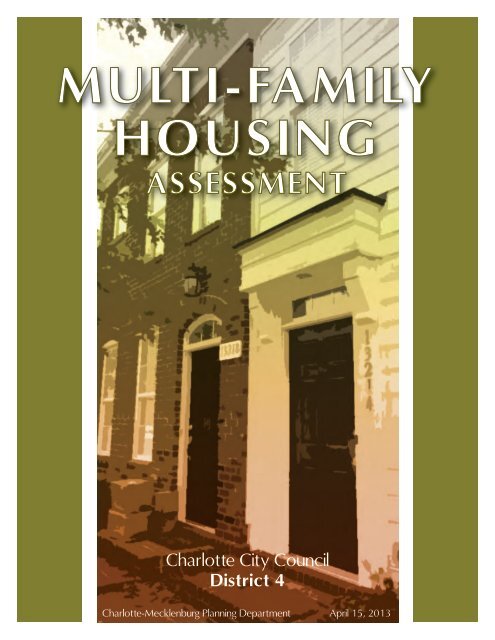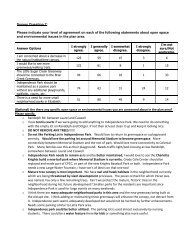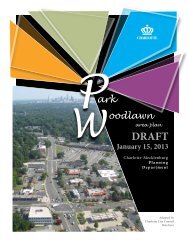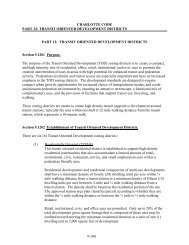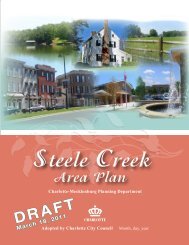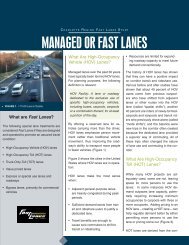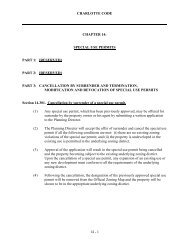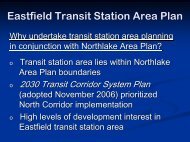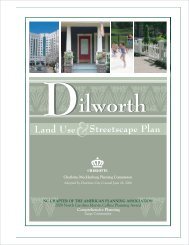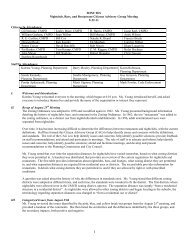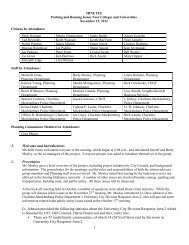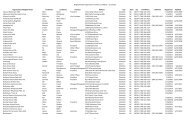MULTI-FAMILY HOUSING - Charlotte-Mecklenburg County
MULTI-FAMILY HOUSING - Charlotte-Mecklenburg County
MULTI-FAMILY HOUSING - Charlotte-Mecklenburg County
You also want an ePaper? Increase the reach of your titles
YUMPU automatically turns print PDFs into web optimized ePapers that Google loves.
<strong>MULTI</strong>-<strong>FAMILY</strong><br />
<strong>HOUSING</strong><br />
ASSESSMENT<br />
<strong>Charlotte</strong> City Council<br />
District 4<br />
<strong>Charlotte</strong>-<strong>Mecklenburg</strong> Planning Department April 15, 2013
Table of Contents<br />
Executive Summary<br />
ii<br />
PART 1: Multifamily Housing Assessment 1<br />
Purpose and Background 1<br />
Methodology 3<br />
Summary of Findings 6<br />
Existing Supply 6<br />
Current Market Demand 8<br />
MAPS<br />
Map 1 District 4 Boundary Map 1<br />
Map 2 Existing Land Use Map 4<br />
Map 3 Multifamily Development 5<br />
Location Map<br />
Map 4 Adopted Future Land Use 7<br />
Map 5 Adopted Plans 12<br />
Preliminary Recommendations 9<br />
Map 6 Existing Zoning 13<br />
PART 2: Appendix 11<br />
List of Supporting Information 11<br />
GRAPHICS AND TABLES<br />
Existing Mulitfamily in District 4<br />
ii<br />
Graphic 1 - Existing Land Uses 1<br />
for District 4<br />
Graphic 2 - Existing Land Uses 2<br />
or All Districts<br />
Graphic 3 - Existing Residential Units 2<br />
by Type for All Districts<br />
Graphic 4 - Existing Multifmaily 3<br />
for District 4<br />
Graphic 5 - Build Out Projections 6<br />
for Multifamily in District 4<br />
Graphic 6 - Estimated Demand for 8<br />
Multifamily in District 4<br />
City of <strong>Charlotte</strong> - District 4 Multifamily Housing Assessment<br />
i
District 4 Multifamily Housing Assessment<br />
Executive Summary<br />
Purpose and Background<br />
This report summarizes the amount of existing, future<br />
projections and market demand for multi-family<br />
residential development in District 4. Information for<br />
the other six Council Districts is also provided to give<br />
comparative context for the District 4 information.<br />
C<br />
C<br />
Existing Multifamily in District 4<br />
Residential Type<br />
Units<br />
% of<br />
Total<br />
Single Family Detached 27,836 60%<br />
Multifamily 18,123 40%<br />
Existin<br />
Methodology<br />
The analysis included a four tier approach using<br />
information within Geographic Information System<br />
(GIS) to quantify the number of multi-family dwelling<br />
units within Council District 4. Staff also included data<br />
from a market demand analysis performed by Noell<br />
Consulting Group.<br />
Summary of Findings<br />
Existing Supply of Multifamily Residential<br />
• Residential land uses is the major land use in District<br />
4. Multifamily is the second largest residential type<br />
as shown in the table to the right.<br />
• District 4 is ranked 5th amongst the seven Council<br />
Districts for existing multi-family development.<br />
• There are 13,573 multi-family units approved via<br />
conditional rezonings that have not been<br />
constructed.<br />
• Districts 1, 3, and 6 have the greatest estimated<br />
share of rental apartments, each having more than<br />
15,000 rental apartment units.<br />
Current Market Demand<br />
• Between 2000-2010, District 4 was the second most<br />
active market for new multifamily development.<br />
• Over the next 25 years, demand will remain strong<br />
in District 4, largely in the form of rental apartments<br />
and for-sale townhouses.<br />
Townhouse 3,021 7%<br />
Duplex/Triplex 65 0%<br />
Condominium 2,301 5%<br />
Apartment 12,736 28%<br />
Total 45,959 100%<br />
• District 4 will continue to experience significant<br />
residential growth with LRT access as well as quick<br />
access to University Research Park, I-85, I-485, and I-77<br />
employment cores (via I-485), and UNC-<strong>Charlotte</strong>. This<br />
area will account for 22.5% of all multi-family demand in<br />
the city.<br />
Preliminary Recommendations<br />
Most multi-family developments within District 4 are<br />
consistent with adopted land use policies for the area.<br />
However, as the area continues to experience growth and<br />
redevelopment, staff has developed several strategies to<br />
address the expected demand:<br />
• Align existing multi-family developments with current<br />
zoning and recommended land use policy.<br />
• Consider Community Design Guidelines specifically for<br />
multi-family development.<br />
• Continue to improve household income levels by locating<br />
major employment centers with moderate to high job<br />
salaries. Higher income values impact housing demand.<br />
• Assess appropriate location and density of existing and<br />
proposed multi-family in future area planning initiative(s).<br />
City of <strong>Charlotte</strong> - District 4 Multifamily Housing Assessment<br />
ii
Purpose and Background<br />
In June 2011, Council member Michael Barnes requested an assessment of multi-family development within Council<br />
District 4 in response to a recent increase in multi-family development activity in his district.<br />
District 4 is approximately 35,000 acres located in the Northeastern<br />
portion of <strong>Mecklenburg</strong> <strong>County</strong> with 41% located in the<br />
Growth Corridor and 52% in the Wedge area according to<br />
Centers, Corridors, and Wedges Growth Framework. Similarly,<br />
as shown in Graphic 1 below, the major land use in the area is<br />
residential, but District 4 is also home to many of the City’s<br />
major employment and educational centers such as the University<br />
of Carolina at <strong>Charlotte</strong> (UNCC), Central Piedmont Community<br />
College - Harris Campus and the University Research Park.<br />
With access to major transportation facilities such as I-85, I-485<br />
and the proposed light rail project - the Blue Line Extension,<br />
this area will continue to be a desirable place to live, work and<br />
recreate.<br />
The purpose of the information in this report is to provide a<br />
quantitative assessment of the following:<br />
1. Existing single-use multi-family development;<br />
2. Projections for multi-family residential development<br />
based on existing land use policy; and<br />
3. Demand for multi-family development through 2035.<br />
In addition, the report summarizes the amount of existing<br />
multi-family units for the other six Council Districts to give<br />
comparative context for the District 4 information. All districts<br />
also include parcels within <strong>Charlotte</strong>’s Extraterritorial Jurisdiction<br />
(ETJ).<br />
Existing Land Use - Graphic 1<br />
Existing Land Use Acres % of Total<br />
Single Family - Detached 11,269 37%<br />
Multi-Family 1,637 5%<br />
Mixed Use 151 0.5%<br />
Agriculture 1,152 4%<br />
Civic/Institutional 2,356 8%<br />
Office 993 3%<br />
Retail 1,064 3%<br />
Industrial 577 2%<br />
Warehouse/Distribution 598 2%<br />
Transportation 85 0.3%<br />
Utility 324 1%<br />
Open Space/Recreation 3,111 10%<br />
Vacant 7,405 24%<br />
Total 30,722 100%<br />
City of <strong>Charlotte</strong> - District 4 Multifamily Housing Assessment 1
Existing Land Use Acreages for All Districts - Graphic 2<br />
Existing Land Use 1 2 3 4 5 6 7<br />
<strong>Charlotte</strong><br />
Sphere<br />
Single Family - Detached 6,648 14,578 15,388 11,269 11,357 11,885 12,945 84,070<br />
Multi-Family 1,955 1,202 1,772 1,637 1,569 2,315 2,995 13,444<br />
Mixed Use 335 350 353 151 59 152 48 1,449<br />
Agriculture 2 366 995 1,152 27 21 316 3,079<br />
Civic/Institutional 1,489 1,794 2,953 2,356 1,380 1,278 1,418 12,668<br />
Office 582 411 1,663 993 208 499 418 4,774<br />
Retail 855 866 1,874 1,064 948 819 613 7,039<br />
Industrial 792 2,272 4,199 577 472 44 388 8,744<br />
Warehouse/Distribution 871 1,828 4,130 598 90 113 15 7,645<br />
Parking 65 112 48 3 2 13 4 248<br />
Transportation 387 417 4,406 82 100 52 5,445<br />
Utility 42 855 1,415 324 150 249 339 3,374<br />
Open Space/Recreation 1,087 3,527 5,623 3,111 1,955 2,138 4,518 21,957<br />
Vacant 1,071 6,068 18,010 7,405 4,037 855 1,951 39,397<br />
Total 16,181 34,646 62,830 30,722 22,554 20,432 25,967 213,332<br />
Existing Residential Units by Type for All Districts - Graphic 3<br />
Residential Type 1 2 3 4 5 6 7<br />
<strong>Charlotte</strong><br />
Sphere<br />
Single Family Detached 23,470 32,521 30,957 27,836 26,434 24,925 29,750 195,893<br />
Multi-family 25,014 17,484 21,818 18,123 18,640 23,948 16,496 141,523<br />
Townhouse 841 2,356 2,748 3,021 1,983 2,556 5,739 19,244<br />
Duplex/ Triplex 2,563 955 943 65 653 515 193 5,887<br />
Condominium 6,678 3,743 1,830 2,301 1,994 5,719 2,267 24,532<br />
Apartment 14,932 10,430 16,297 12,736 14,010 15,158 8,297 91,860<br />
Total 48,484 50,005 52,775 45,959 45,074 48,873 46,246 337,416<br />
City of <strong>Charlotte</strong> - District 4 Multifamily Housing Assessment 2
Residential Type<br />
Existing Multifamily in District 4 - Graphic 4<br />
Units<br />
% of<br />
Total<br />
Existing Land Use<br />
Single Family Detached 27,836 60%<br />
Multifamily 18,123 40%<br />
Townhouse 3,021 7%<br />
Duplex/Triplex 65 0%<br />
Condominium 2,301 5%<br />
Apartment 12,736 28%<br />
Total 45,959 100%<br />
Methodology<br />
For the purposes of this report, staff defined multi-family as attached residential dwelling units with a land use<br />
category or zoning classification with a density greater than or equal to eight (8) dwelling units to the acre. The<br />
analysis included a four tier approach using information within Geographic Information System (GIS) to quantify<br />
the number of multi-family dwelling units within Council District 4 and a market demand analysis performed by<br />
Noell Consulting Group.<br />
1. Tier One included an assessment of existing multi-family units currently built as recorded in the<br />
current tax parcel database.<br />
2. Tier Two included an assessment of vacant land that has been conditionally approved with a rezoning<br />
(CD plan) or is zoned (by-right) with a zoning classification that allows single-use multi-family develop<br />
ment. This tier of analysis included an individual review of each approved conditional rezoning petition<br />
within District 4 to record the number of units approved within that CD plan.<br />
3. Tier Three included an assessment of development potential for vacant land not zoned for multi-family<br />
but has been recommended for multi-family development by a Council adopted area plan policy. For<br />
the land use recommendations with no specific residential density, staff used the General Development<br />
Policies (GDP) software to determine a potential residential density for individual parcels. The GDP<br />
software uses a point system matrix to identify the appropriate location for multi-family residential<br />
and the appropriate density for a specific location.<br />
4. Tier Four estimated demand for attached housing by Council District between 2010 and 2035. Noel<br />
group created a long-term growth model for the City of <strong>Charlotte</strong> that estimates demand by product<br />
type (townhouse and multifamily, both owner and rental) using household growth estimates, and<br />
consumer research data for housing preferences.<br />
The concluding information for this analysis will illustrate the build-out projects for multi-family within<br />
District 4.<br />
City of <strong>Charlotte</strong> - District 4 Multifamily Housing Assessment 3
City of <strong>Charlotte</strong> - District 4 Multifamily Housing Assessment 4
City of <strong>Charlotte</strong> - District 4 Multifamily Housing Assessment 5
Build Out Projections for Multifamily in District 4 - Graphic 5<br />
Land Use Type<br />
Existing Approved Recommended Build-out<br />
Vacant Land not Potential<br />
zoned MF but Multifamily<br />
Vacant Land Vacant Land Recommended<br />
Zoned Zoned for MF per<br />
Existing Multi-family Multi-family Adopted Future Approved +<br />
Multi-family (CD) (By Right) Land Use Recommended<br />
Total<br />
Multifamily<br />
Existing +<br />
Approved +<br />
Recommended<br />
Residential
City of <strong>Charlotte</strong> - District 4 Multifamily Housing Assessment 7
Estimated Demand for Multifamily in District 4 from 2010 - 2035 - Graphic 6<br />
Area<br />
Single Family<br />
Owner & Rental<br />
Multi-family*<br />
Owner & Rental<br />
Multi-family<br />
Owner<br />
Multi-family<br />
Rental<br />
Townhouse<br />
Owner<br />
Townhouse<br />
Rental<br />
District 4 20,300 23.3% 18,886 18.6% 966 5.4% 12,514 22.5% 4,770 20.2% 635 14.4%<br />
<strong>Charlotte</strong><br />
Sphere<br />
87,228 100% 101,612 100% 17,897 100% 55,688 100% 23,615 100% 4,412 100%<br />
Summary of Findings<br />
Current Market Demand<br />
• Between 2000-2010, District 4 was the second most active market for new multifamily development,<br />
averaging 850 units annually during the period, well above the 587 unit average for all Districts.<br />
• Over the next 25 years, demand will remain strong in District 4, largely in the form of rental apartments<br />
and for-sale townhouses, with demand for condos being minimal.<br />
• Relatively moderate home prices and a lack of urban cores will temper demand in District 4 over time.<br />
Significant investments along the Blue Line Extension—particularly those closest to UNC-<strong>Charlotte</strong>—<br />
could spur increased demand for new for-sale condominium units.<br />
• District 4, which will also enjoy LRT access as well as quick access to University Research Park, I-85 and<br />
I-77 employment cores (via I-485), and UNC-<strong>Charlotte</strong> growth, will remain a highly active area for new<br />
rental multifamily development as well, with demand existing for more than 12,500 rental multifamily<br />
units in the coming 2.5 decades; equating to 22.5% of all demand in the city.<br />
• Districts 3 and 4 will capture 18.6% and 20.2% of demand for new owner townhomes in the coming 25<br />
years. These areas feature relatively abundant greenfield development opportunities and solid access to<br />
growing employment cores.<br />
• The greatest market depth will be for single-family homes in more moderately-priced areas with green<br />
field development opportunities, including Northeast <strong>Charlotte</strong> (District 4), Northwest <strong>Charlotte</strong> (District<br />
2) and Southwest <strong>Charlotte</strong> (District 3). These areas will continue to capture the greatest share of<br />
demand in the coming years, with overall demand for single-family homes gradually decreasing as a<br />
result of demographic shifts and dwindling land supply.<br />
• Fairly significant greenfield development, strong freeway access, extension of the Blue Line LRT into the<br />
area, and proximity to growing employment cores will combine to drive demand in District 4; the stron<br />
gest single-family growth market in the city. Over the next 25 years, it is estimated District 4 will capture<br />
around 20,300 units (23.3% of all new single-family units in the city). This accounts for more than half of<br />
all of the growth occurring in District 4 in the coming 25 years (39,186 households). District 3, benefiting<br />
from these same factors, will account for the second greatest capture of demand, capturing nearly<br />
18,619 units between 2010 and 2035.<br />
• Limited land supply will temper demand for new for-sale single-family product in the coming 25 years,<br />
with the greatest market-rate opportunities occurring in highly affluent neighborhoods. Land costs in<br />
these neighborhoods require high home prices, limiting demand to more affluent demographics.<br />
City of <strong>Charlotte</strong> - District 4 Multifamily Housing Assessment 8
Preliminary Recommendations<br />
As shown on the Multi-Family Assessment Map on page 5, most multi-family developments within District 4 are<br />
located within the Northeast Growth Corridor or Mixed Use Activity Center, consistent with the adopted land use<br />
policies shown on the Adopted Land Use Map, page 7 . However, as the area continues to experience growth and<br />
redevelopment, staff has developed several strategies to address the potential for multi-family developments. The<br />
following strategies were developed:<br />
1. Align existing multi-family developments with current zoning and recommended land use policy. Staffinitiated<br />
rezonings or corrective rezoning are most often recommended as an implementation strategy in<br />
an area plan process to:<br />
• Align zoning with existing land use to make future land uses compatible with existing development;<br />
• Align zoning with the currently adopted land use plan; and/or<br />
• Protect environmentally sensitive areas.<br />
Existing multi-family developments that have not been built to the current zoning rights were assessed for<br />
potential corrective rezonings. Based on their current dwelling units per acre (dua), type of multi-family and<br />
the age of the development, the following parcel was identified as a suitable candidate for a corrective<br />
rezoning:<br />
Parcel = 08902220 (Apartments Garden Style)<br />
Acres = 1.26<br />
Number of Units = 13 at 10.05 DUA<br />
Year Built = 1970<br />
Existing Zoning = R-17MF, surrounding parcels are zoned R-4<br />
Location: Edge of corridor and wedge, nearest intersection is Wellingford St and Springview Rd<br />
2. Consider corrective rezonings for undeveloped multi-family developments with conditional plans<br />
approved before 2005 which was prior to the community design guidance provided in the City’s General<br />
Development Policies. Most community concerns with multi-family development are centered around<br />
poor site design, lack of connectivity to surrounding uses, and on-site amenities. Listed below are seven<br />
conditional site plans that include approved multi-family development component that also meets the<br />
aforementioned criteria.<br />
Petition Zoning Acres<br />
Potential MF<br />
Units<br />
1989-041(C)<br />
B-2(CD)<br />
109.51 2,409<br />
1998-100 B-1(CD) 3.32 73<br />
2001-006 R-17MF(CD) 9.88 128<br />
2001-070 CC 51.00 494<br />
2003-076 CC 138.00 1,770<br />
1998-117 B-2(CD) 16.83 110<br />
1999-033(C) CC 28.21 422<br />
Total 356.75 5,406<br />
City of <strong>Charlotte</strong> - District 4 Multifamily Housing Assessment 9
Preliminary Recommendations - continued<br />
3. Consider Community Design Guidelines specifically for multi-family development. Newer multi-family develop<br />
ments with more architecutural features, well-connected, walkable streets and on-site amenities have<br />
illustrated that good design features help to create and improve value in residential developments. Planning<br />
staff have developed draft multi-family design guidelines that could become Council adopted policy.<br />
4. Continue to improve household income levels by locating major employment centers with moderate to high job<br />
salaries. Demographic projections show that 37% of the residential market income distribution will be<br />
between $45,000 and $99,000. 27% of the residential market income distribution is expected to exceed<br />
$100,000. With higher income levels and more jobs locating in the area, the demand for quality and higher<br />
home values is likely to increase.<br />
5. Assess appropriate location and density of existing and proposed multi-family in future area planning<br />
initiative(s). Staff found some areas where district plans have recommended multi-family land uses in areas<br />
surrounded by much lower density developments. These areas will be reassessed for an appropriate use<br />
during area plan processes (Prosperity Hucks Plan currently underway) and are shown in the table below.<br />
Additional properties will be assessed during a future planning intiative for the Sugar Creek/I-485 area.<br />
Land Use Recommendations from Prosperity Hucks Area Plan<br />
Currently Adopted<br />
Future Land Use<br />
Acres<br />
Potential<br />
MF Units<br />
Recommended Land<br />
Use Change<br />
Recommended<br />
Units<br />
Multi-family 18.25 78 Residential
Appendix<br />
Supporting Information<br />
C<br />
C<br />
April 2013<br />
Resources<br />
Geographic Information Systems compiled data using the following:<br />
Existing Land Use<br />
Existing Zoning<br />
Approved and Pending Rezoning Petitions<br />
Approved Conditional Plans<br />
Subdivision Multi-family (including Urban Plans) and Mixed Use Plans<br />
General Development Policies (2003)<br />
Adopted Future Land Use Policy:<br />
I-485 Interchange Analysis (1999)<br />
Prosperity Church Villages (1999)<br />
Northeast Area Plan (2000)<br />
Newell Small Area Plan (2002)<br />
Existing Land Use<br />
Rocky River Area Plan (2006)<br />
University City Area Plan (2007)<br />
University Research Park Area Plan (2010)<br />
<strong>Charlotte</strong> Multifmaly Demand by District by Noel Consulting Group (2013)<br />
City of <strong>Charlotte</strong> - District 4 Multifamily Housing Assessment 11
City of <strong>Charlotte</strong> - District 4 Multifamily Housing Assessment 12
City of <strong>Charlotte</strong> - District 4 Multifamily Housing Assessment 13


